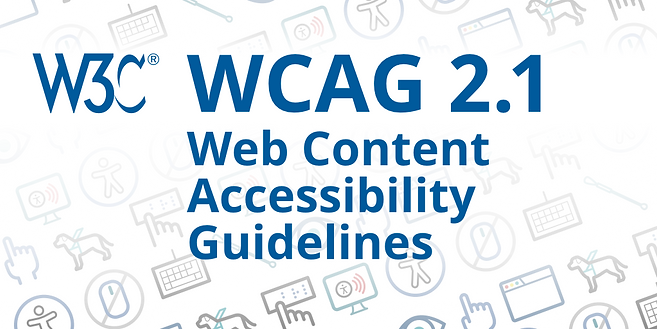.png)

WCAG 2.1
WCAG 2.1
Web Content Accessibility Guidelines (WCAG) 2.1 is an extension of the original WCAG 2.0 and introduces additional success criteria to enhance web accessibility. Please note that standards and guidelines may evolve, and it's advisable to refer to the latest WCAG documentation for the most up-to-date information. Here are the key details about WCAG 2.1:
-
Purpose of WCAG 2.1:
-
WCAG 2.1 was developed to address accessibility issues not covered in WCAG 2.0 and to improve the overall inclusivity of web content.
-
-
New Success Criteria:
-
WCAG 2.1 includes 17 additional success criteria that supplement the existing ones in WCAG 2.0.
-
These new criteria aim to address the accessibility needs of users with cognitive and learning disabilities, as well as users with mobile devices.
-
-
Three Levels of Conformance:
-
WCAG 2.1, like WCAG 2.0, defines three levels of conformance: Level A, Level AA, and Level AAA. Each level represents a progressively higher standard of accessibility.
-
-
Key Focus Areas in WCAG 2.1:
-
Mobile Accessibility: WCAG 2.1 introduces criteria specifically addressing mobile device usability and touchscreen interactions.
-
Cognitive and Learning Disabilities: New success criteria aim to improve the accessibility of content for users with cognitive and learning disabilities.
-
-
Examples of New Success Criteria in WCAG 2.1:
-
Mobile Accessibility:
-
Ensuring that content can be operated using a single pointer and does not require gestures beyond a single tap.
-
Making sure that there is sufficient spacing and touch target sizes for clickable elements on touchscreens.
-
-
Cognitive and Learning Disabilities:
-
Providing options for users to customize the presentation of content, such as text spacing and font styles.
-
Creating content that is easily understandable and avoids complex language or interactions that might be confusing.
-
-
-
Impact on Existing Content:
-
Organizations aiming for WCAG compliance may need to assess and update existing content to meet the new success criteria introduced in WCAG 2.1.
-
-
Timeline and Adoption:
-
WCAG 2.1 was published in June 2018, and its adoption has become more widespread as organizations and developers work towards ensuring a higher level of inclusivity in web design and development.
-
-
Accessibility for Emerging Technologies:
-
WCAG 2.1 takes into consideration the accessibility challenges posed by emerging technologies, providing guidelines for creating accessible content across different platforms.
-

